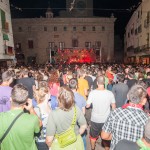Originaly published in La Coctelera on May the 5th-2009
Introductory text of the international Conference of performing arts that will takes place in Huesca (Spain) from September 30 to October 2 in 2009
It is too often a fact that the most innovative and avant-garde theatre and dance rarely form part of theatre programmes. The reasons that are put forward to explain this absence are highly diverse, although most of them are to do with their low level of acceptance by a general public that, in general, is more accustomed to viewing the performing arts as pure entertainment or as the reflection of education based on heritage and history rather than a processes of contemporary creation. Another factor is that in times of crisis, the public authorities cut down on the budget assigned to those areas of culture that are considered to be less popular.
Whatever the reasons may be, in this congress we are going to take a positive attitude and not merely describe the difficult reality faced by contemporary performing arts. We have invited nine relevant figures in different fields of the performing arts at international level and will ask them to explain why they consider that today’s performing spaces should find a place in their programmes for contemporary creations. Each of the speakers will bear witness to a situation in which they have stood out and together they will present a detailed set of arguments in favour of the appropriateness of programming innovative, audacious productions in theatres.
Using a more current expression: in the conferences we hope to shed light on the reasons for an I+D+i of the performing arts at this particular moment in time. In the “European Year of Creativity and Innovation” and immersed, as we are, in a global crisis of yet unknown proportions, resorting to the most innovative artistic creations is considered as a detonator for new social, economic and personal development. This detonator is, in the performing arts, the contemporary nature of the artistic proposals and their accessibility for most of society.
Wednesday 30 September
Table 1 – Artistic reasons
Committing ourselves to art and making it accessible to the general public should not need any justification. “Art for art’s sake” has been one of the main philosophical arguments since ancient times: “the need for art is self-justified”. In this context “What place do contemporary performing arts occupy?”, “Do they have intrinsic worth?” and if so, “What defines them and what differentiates them to other performing disciplines?”
Thursday 1st October
Table 2 – Socio-economic reasons
Lately the argument of economic progress is that which has most frequently been bandied about in Spain by politicians and administrations to justify their support of the arts. However the question is, are contemporary arts capable of reactivating an economy in crisis? Can a society in need of innovation help artists’ creativity? Are creative minds necessary for a new type of society? Is this perhaps the first step towards educating in creativity?
Friday 2nd October
Table 3 – Social and personal reasons
Contemporary creation feeds off the reality of the society in which it is developed once again returning said creativity to it. Its receivers, be they individuals or groups, become more aware, transform and develop their own creativity, strengthening their capacity to co-exist and overcoming the barriers of exclusion. Is the population receptive to contemporary creation? Does its transforming capacity affect those that practice it? Is there creation beyond the Academy?





